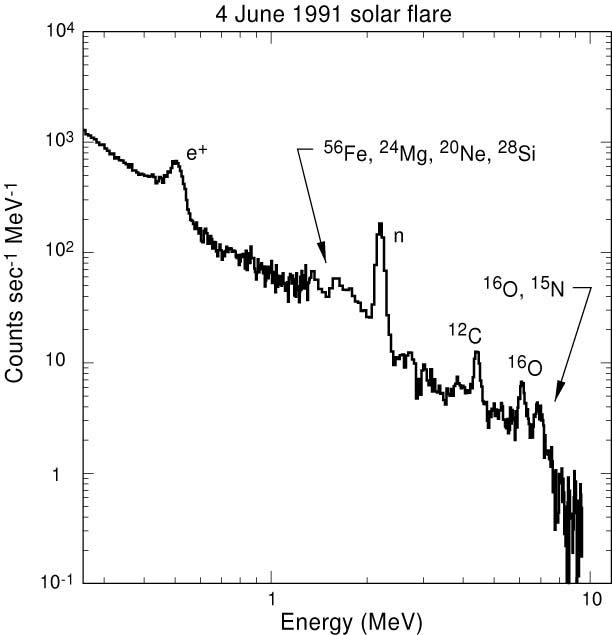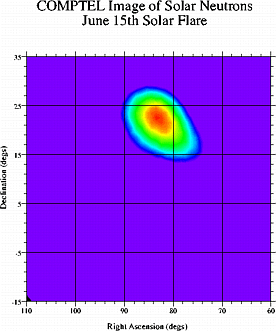| BELOW: Details in the OSSE solar spectrum help identify the nature
of particle acceleration during solar flares.


The COMPTEL image is a remarkable picture of the Sun in the "light"
of neutrons.
|
While not as mysterious as gamma-ray bursts, solar flares can be just
as exciting. Most normal stars are not candidates for study by Compton
instruments, but the Sun is so close by that even weak emission can be
detected. In the case of solar flares, which are highly energetic bursts
of radiation from the Sun due to acceleration of particles in loops formed
in the outer solar atmosphere, the same capabilities BATSE uses to detect
cosmic gamma-ray bursts are used for flare studies. Flare activity is related
to the so-called solar cycle, an approximately 11-year period during which
solar activity (and hence flares and sunspots) go through relative maxima
and minima. The launch of Compton came shortly after such a solar maximum.
Luckily, solar activity was still at a very high level and valuable observations
were made. Compton will still be in orbit during the next solar maximum.
Much has been learned about the fundamentals of particle acceleration in
solar flares from Compton observations. Gamma-ray observations can also
provide information on which elements are present in the ambient coronal
gas. By studying the gamma-ray time history of flares, and correlating
the gamma-ray emission with observations at other wavelengths, it has been
discovered that particles are accelerated for much longer periods of time
than just the impulsive beginning of the flare. An example of such a flare
was detected on June 4, 1991. EGRET, COMPTEL, and OSSE all detected evidence
for particle acceleration lasting for several hours. This flare was one
of the few energetic enough to be detected by all the Compton experiments.
These broadband observations are very important. Perhaps one of the most
intriguing observations |
yet made by Compton is the COMPTEL detection of neutron flux from a
solar flare. Neutrons interact in the COMPTEL instrument in a manner similar
to that of gamma rays. Usually, neutrons are removed from the data as contaminants.
During a flare, however, solar neutrons are actually a valid signal considered
worthy of study. As a result, not only can COMPTEL construct an image of
the Sun in the light of gamma rays, but an actual image of the Sun using
neutron flux can be formed! This is a remarkable achievement. Neutrons
decay with a half life of 5 minutes, so it is unlikely that any other astrophysical
systems could ever be detected via neutron flux.
GRO J1655-40: A Galactic Transient
Most sources which exhibit time variability are a little less spectacular
than bursts, but just as important. For example, in late July of 1994,
BATSE began to detect a strong, previously unknown source of low-energy
gamma radiation from the direction of the southern constellation Scorpius.
The source, dubbed GRO J1655- 40, rapidly increased in brightness, becoming,
over the course of about 10 days, among the brightest sources in the sky
in BATSE's sensitivity range. But what was it? Its "light curve",
which is a term astronomers use in referring to the source brightness as
a function of time, vaguely resembled that of previously known transient
objects which consist of a neutron star orbiting a very luminous, hot,
young star. On the other hand its spectrum, which is simply the number
of photons emitted versus photon energy, resembled that of another class
of transient objects which consist of a much dimmer, cooler, old star orbiting
a black hole.
|
